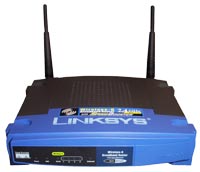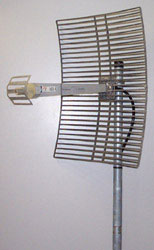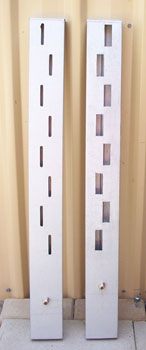Wireless Networking
(Difference between revisions)
m (removed e3.com.au link from WA community network links) |
|||
| (2 intermediate revisions by 2 users not shown) | |||
| Line 87: | Line 87: | ||
*[http://www.brismesh.org Brismesh] (Brisbane) | *[http://www.brismesh.org Brismesh] (Brisbane) | ||
*[http://cairns.wireless.org.au Cairns Wireless] (Cairns) | *[http://cairns.wireless.org.au Cairns Wireless] (Cairns) | ||
| + | *[http://www.ips-mesh.net/ Ipsmesh] (Ipswich) | ||
*[http://ddwireless.net Darling Downs Wireless] (Toowoomba) | *[http://ddwireless.net Darling Downs Wireless] (Toowoomba) | ||
| + | |||
== South Australia == | == South Australia == | ||
*[http://www.air-stream.org Air-Stream] (Adelaide) | *[http://www.air-stream.org Air-Stream] (Adelaide) | ||
| Line 98: | Line 100: | ||
== Western Australia == | == Western Australia == | ||
| − | *[http://wafreenet.org WAFreeNet] (Perth, [ | + | *[http://wafreenet.org WAFreeNet] (Perth) |
| + | |||
| + | |||
| + | ==More Links== | ||
| + | *[[Networking]], [[Network Protocols]], [[Network Problems]], [[Network Troubleshooting]] | ||
| + | *[[Wireless Network Security]] | ||
| + | *[[Review:Linksys AG241 ADSL2 Modem Gateway]], [[Routers]] | ||
| + | *[[DebIPsec]] | ||
[[category:hardware]] | [[category:hardware]] | ||
[[category:networking]] | [[category:networking]] | ||
Latest revision as of 17:23, 19 September 2013
Contents |
[edit] Wireless Standards
- 802.11b
- provides speeds upto 11Mbps at 2.4GHz
- 802.11g
- provides speeds upto 54Mbps at 2.4GHz
- 802.11a
- provides speeds upto 54Mbps at 5.8 GHz
- 802.11n
- an unratified standard that should provide speeds of upto 100Mbps (WWiSE and MIMO are two competing proposals for 802.11n)
[edit] Wireless Concepts
- LOS
- Line-of-sight; if two locations have a clear, unobstructed view of each other, they are said to have good LOS. Because microwave energy is absorbed by solid obstructions, LOS is required for a good wireless signal between two locations.
- Beamwidth
- The beamwidth of an antenna is the angle between the half-power (3 dB) points of the main lobe, when referenced to the peak effective radiated power of the main lobe, usually expressed in degrees (and usually given in the horizontal plane).
- Bandwidth
- the amount of data that can be transferred in a given time period, normally measured in kbps (kilobits per second) or Mbps (megabits per second).
- Frequency
- The number of cycles per second. The frequency of 802.11b ranges from 2.412 GHz (channel 1) to 2.477 GHz (channel 14).
- Gain
- In antenna design, gain is the logarithm of the ratio of the antenna's radiation pattern to that of some ideal antenna, typically the theoretical isotropic antenna.
- dB
- a measure of the ratio between two quantities, and commonly used to measure signal-to-noise ratios.
- SNR
- Signal-to-noise ratio is the power ratio of the signal (meaningful data) and the background noise.
[edit] Wireless Security
Please see Wireless Network Security.
[edit] Antennas
If you want to improve the range of the standard "rubber-ducky" antenna(s) on your wireless AP/router, before spending money on a higher gain antenna, try making some simple reflectors for the standard antenna, as detailed on the deep Dish Cylindrical Parabolic Template website.
[edit] Antenna Types
- Omni-directional
- radiates a signal in multiple directions, typically 90, 180 or 360 degrees.
- Directional
- typically focuses the signal in a single direction.
Omni-directional antennas are typically used in situations where multiple clients will be connecting, from multiple directions. A directional antenna is preferred for point-to-point links, as the signal is focussed in the direction you want, rather than being dispersed in multiple directions. Noise is also reduced, and you're also reducing the amount of RF "pollution".
[edit] Antenna Polarisation
Polarisation is defined as the orientation of the electric field of an electromagnetic wave. Two often used special cases of elliptical polarization are linear polarization and circular polarization. The initial polarization of a radio wave is determined by the antenna that launches the waves into space.
- Linear Polarisation
- the electric field vector stays in the same plane
- Circular Polarisation
- the electric field vector appears to be rotating with a circular motion about the direction of propagation (can be either right-hand or left-hand rotation)
The Helical antenna is circularly polarised, while all other antennas listed below are linearly polarised, with the linear polarisation being either vertical or horizontal, depending how the antenna is oriented.
[edit] Homebrew Antennas
The majority of the antennas listed below can be constructed at home with tools that most people will have in their shed.
[edit] Cantenna
[edit] Biquad
- Biquad antenna construction - easy-to-build 11dBi antenna with approx 40 degrees beamwidth
- Double biquad antenna - 13dBi version of the biquad
- BiQuad 802.11b Antenna - theory behind the biquad antenna
[edit] Dishes
[edit] Helical
[edit] Collinear
[edit] Slotted Waveguide
- How to make a 'Downpipe' Slotted Waveguide Omni antenna
- 802.11b WLAN Waveguide Antennas - theory and design of the slotted waveguide
[edit] Patch Antenna
[edit] Discone
- Tim Kyle's discone antenna for 802.11b Wi-Fi
- another discone (not in English)
[edit] other Omni Antennas
[edit] Community Networks
Most major cities have a community wireless network (aka freenet), consisting of like-minded individuals who have established a wireless network between their houses and other elevated places with good LOS.
If you're interested in getting involved, contact your local freenet for more help and assistance.
[edit] ACT
- Air.Net (Canberra)
[edit] New South Wales
- Sydney Wireless (Sydney)
- Bathurst Wireless (Bathurst)
[edit] Northern Territory
- Darwin Wireless (Darwin)
- Darwin Mesh (Darwin)
[edit] Queensland
- Brismesh (Brisbane)
- Cairns Wireless (Cairns)
- Ipsmesh (Ipswich)
- Darling Downs Wireless (Toowoomba)
[edit] South Australia
- Air-Stream (Adelaide)
[edit] Tasmania
- TasWireless (Hobart)
[edit] Victoria
- Melbourne Wireless (Melbourne)
- Ballarat Wireless (Ballarat)
- Geelong Wireless (Geelong)
[edit] Western Australia
- WAFreeNet (Perth)
![[Main Page]](http://www.overclockers.com.au/wiki/skins/common/images/wiki.png)


